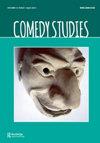In-groups, out-groups, and comic synchrony in Bo Burnham’s Make Happy (2016)
Q1 Arts and Humanities
引用次数: 0
Abstract
Abstract Examining Bo Burnham’s stand-up comedy special, Make Happy (2016), this article proposes the concept of comic synchrony, a mode of discourse used to speak both ironically and sincerely at once. Initially, audiences read Burnham’s utterances as wholly ironic or sincere depending upon their membership in an in-group or out-group. Comic synchrony occurs through the layering of concurrent discourse communities that complicate the use of shared rhetorical modes between speaker and interpreter. I argue that audience membership in coexisting and permeable discursive circles catalyses audience evolution so they come to understand each of the Burnham’s utterances as ironic and sincere simultaneously. Through this model, the comedian levels biting critique toward the assembled audience and, more broadly, contrived performance—meaning each attack and not meaning it at the same time. The result is a rhetorical configuration that interrogates the ambivalent relationship between irony and sincerity, emphasizing the contradictory and conflicting experience of acting out one’s life for an audience.博·伯纳姆的《快乐》(2016)中的内群体、外群体和喜剧同步
本文以博·伯纳姆的单口喜剧特别节目《Make Happy》(2016)为研究对象,提出了喜剧同步的概念,这是一种既讽刺又真诚的话语模式。最初,观众根据他们是内群体还是外群体的成员,将伯纳姆的话语理解为完全讽刺或真诚。喜剧同步性是通过并发话语群体的分层而发生的,这使得说话者和口译者之间共享修辞模式的使用复杂化。我认为,在共存和可渗透的话语圈中,观众的成员资格催化了观众的进化,使他们能够同时理解伯纳姆的每一个话语是讽刺的和真诚的。通过这种模式,喜剧演员向聚集在一起的观众发出尖锐的批评,更广泛地说,是做作的表演——意味着每一次攻击,而不是同时意味着攻击。结果是一种修辞结构,质疑讽刺与真诚之间的矛盾关系,强调为观众表演自己生活的矛盾和冲突体验。
本文章由计算机程序翻译,如有差异,请以英文原文为准。
求助全文
约1分钟内获得全文
求助全文
来源期刊

Comedy Studies
Arts and Humanities-Literature and Literary Theory
CiteScore
0.60
自引率
0.00%
发文量
26
 求助内容:
求助内容: 应助结果提醒方式:
应助结果提醒方式:


